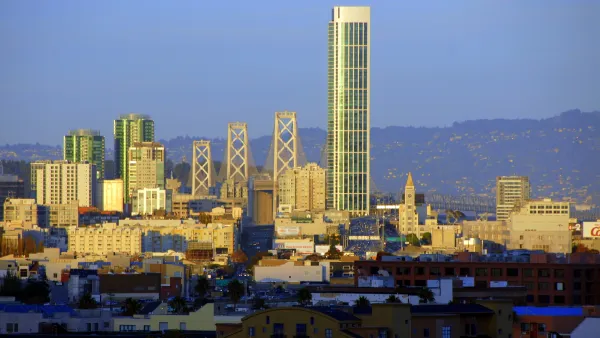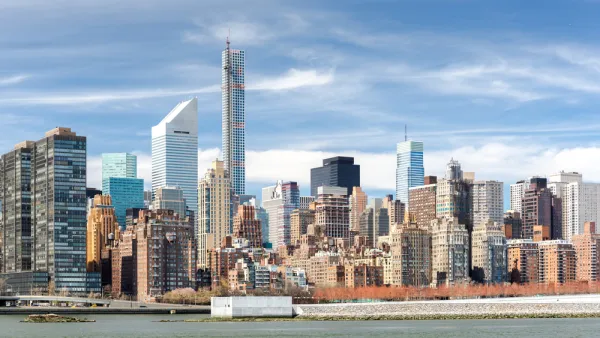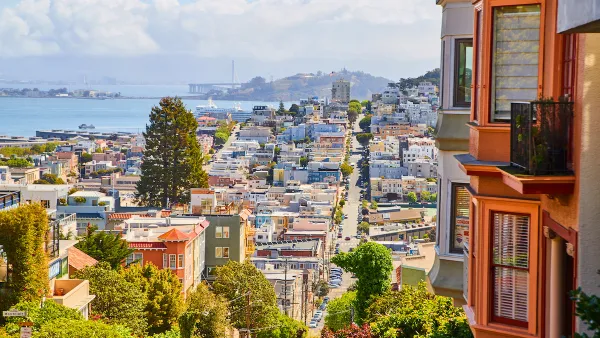We've seen builders responding to high demand for residential housing Manhattan and Seattle, but could it be happening in San Francisco? Sort of, according to San Francisco Chronicle business columnist, Kathleen Pender.
"Could the Bay Area’s housing shortage turn into a surplus?" asks Pender. "Given the number of high-density residential projects that seem to be popping up everywhere, the answer might seem to be yes."
Pender reports on housing permit figures in the five-county San Francisco metro area, consisting of Marin, San Francisco, San Mateo, and in the East Bay's Alameda and Contra Costa counties. Permits "are considered a decent proxy for new housing supply because developers don’t usually pull them until they are ready to break ground. The permit doesn’t typically say whether the home will be for sale or rent."
In the first two months of this year, 2,173 units were permitted, up 89 percent from the same period last year.
Last year, building permits for a total of 12,766 single or multifamily housing units were issued in the San Francisco metro area, 28 percent more than in 2014, according to U.S. Census Bureau data.
A quick look at The Chronicle's map, charts and city list of nine-county Bay Area housing permits points to the three main counties where building is occurring in the nine-county Bay Area: Santa Clara, San Francisco, and Alameda (in order), and the two cities of San Jose (Santa Clara County) and San Francisco.
What's somewhat startling is that the Bay Area's third largest city, Oakland, and second largest in the SF Metro Area and eighth in the state, shows a mere 1,332 permits pulled in the three years from 2013 to 2016. Recent articles may have given the impression of a boom underway there. The only boom would appear to be in rents in light of increasing demand and stalled construction.
Sign of a glut: free rent?
Back on the other side of the Bay, where much high density residential construction is underway, Pender reports on two projects, which, I might add, I ride by on my weekend trips in San Francisco as they are both close to the Caltrain depot. I appreciated seeing the rental prices.
In San Francisco, developer Equity Residential is offering one month free rent at the new Azure Apartments in Mission Bay and at Potrero 1010, a 453-unit complex going up by the Interstate 280 extension. One-bedroom apartments at the Azure start at $3,825 a month. At 1010 Potrero, the most affordable unit is a studio for $2,950.
Now a "glut of affordable $3,825 one-bedrooms and $2,950 studios" may not do much for most folks, but consider the market for these rentals. Per San Francisco Business Times:
Azure Apartments, which includes the tower and a completed five-story low-rise structure, offers 273 units and 396,200 square feet of for-lease residential space targeted to young (and well-paid) professionals commuting to the city’s Financial District and South Bay, said representatives from project developer Equity Residential.
However, as has been posted earlier, these projects moderate rental price increases elsewhere and "indirectly add to low income housing" in the city.
Pender also goes into depth tackling the other side of the housing market — demand, by looking at job creation data, which is largely driving the Bay Area housing market. "[B]uilding (housing) alone is no guarantee that prices will fall," explains Pender.
“It’s almost like adding an additional lane to a highway,” said Christopher Thornberg, founding partner of Beacon Economics. When you add a lane, traffic may not improve much because it encourages more people to drive. Likewise, when you build more housing, you encourage more people to move to California.
While I appreciate Thornberg's highway analogy, because he certainly gets that part right, I'd put the housing supply and demand relationship in a different way. When you build more housing, you may encourage more people to remain in the Bay Area who would otherwise leave.
FULL STORY: Bay Area building boom may not end housing shortage

Analysis: Cybertruck Fatality Rate Far Exceeds That of Ford Pinto
The Tesla Cybertruck was recalled seven times last year.

National Parks Layoffs Will Cause Communities to Lose Billions
Thousands of essential park workers were laid off this week, just before the busy spring break season.

Retro-silient?: America’s First “Eco-burb,” The Woodlands Turns 50
A master-planned community north of Houston offers lessons on green infrastructure and resilient design, but falls short of its founder’s lofty affordability and walkability goals.

Test News Post 1
This is a summary

Analysis: Cybertruck Fatality Rate Far Exceeds That of Ford Pinto
The Tesla Cybertruck was recalled seven times last year.

Test News Headline 46
Test for the image on the front page.
Urban Design for Planners 1: Software Tools
This six-course series explores essential urban design concepts using open source software and equips planners with the tools they need to participate fully in the urban design process.
Planning for Universal Design
Learn the tools for implementing Universal Design in planning regulations.
EMC Planning Group, Inc.
Planetizen
Planetizen
Mpact (formerly Rail~Volution)
Great Falls Development Authority, Inc.
HUDs Office of Policy Development and Research
NYU Wagner Graduate School of Public Service




























